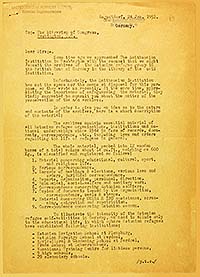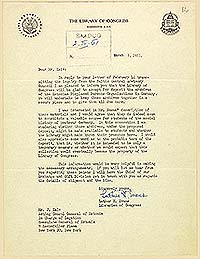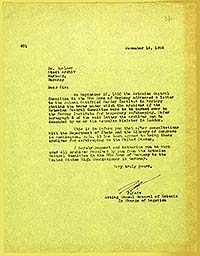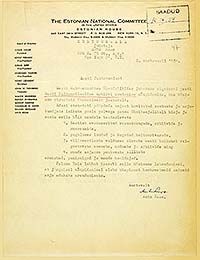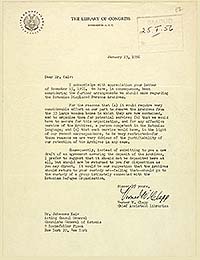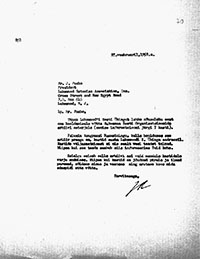Archives
All ethnic groups had to protect and defend their rights and record data as accurately as possible in the DP camps. Inevitably, it was not possible for the DPs to bring all relevant documents from their homeland, but Estonia's recent past made the need for collection and storage arise quickly. Fortunately, there were also people among the DPs who understood how important it was to begin immediately to gather unique documents. One such man was a journalist Ferdinand Kool, who later published a voluminous overview of Estonian DPs in Germany.
In February 1946, an Estonian historical and cultural archive was established in Geislingen, and Jaan Lőoke was made the secretary and manager, Ilmar Arens the director and a five member council was elected. In October 1946, there were 35 employees in the Geislingen archives, the collection comprised of 72 historically important documents, 47 documents of cultural history and 431 documents of other materials. 625 printed publications, 342 newspaper clippings, and more than 1000 photos were sent to the archives. At the beginning of 1948, archives, reaching 11 metres in length, covering over 15,000 pages of documents, more than 1200 photos, 120 complete periodicals, and 269 books were collected.
Due to economic difficulties, the archival activities in the summer of 1948 and archival tasks went to Evald Rink, the director of the Estonian Central Office in the US zone. At the beginning of 1949, the archival duties were passed to the chairman and the vice chairman of the Central delegation. The last major actions of the archives was the questioning of prisoners of war that had returned to Germany – individuals that had been imprisoned in Estonia gave valuable information on the situation of occupied Estonia.
Archives’ management existed only in the US zone, trustworthy volunteers were on duty of communication with the other zones.
| Estonian representative in the Baltic Central Advisory Council, Mr. Hermann Stockeby turns to the Library of Congress for to acquire a repository situating outside Europe for Estonian archival sources in Germany. The amount of records is noticed as 12 wooden boxes with total weight of 600 kilograms. January 24, 1951. ERA.1608.2.1016, pages 10–11 (digitized, www.ra.ee/saaga) |
|
| The Library of Congress confirms to consul general, Mr. J. Kaiv, its willingness to take the archival sources of Estonian Displaced Organizations for a deposit maintenance. ERA.1608.2.1016, page 12 (digitized, www.ra.ee/saaga) |
|
| Estonian consul general, Mr. J. Kaiv, informs Herder Institute, there were kept the archives of Estonian Displaced Organizations in Germany, that the archives will be tranferred to the Library of Congress. ERA.1608.2.1016, page 37 (digitized, www.ra.ee/saaga) |
|
| Board of directors of the Estonian National Committee in the United States decided to found Estonian Cultural Archives on February 8, 1954. Every interested person and organization is asked to send there information about libraries, archives and museums founded abroad or evacuated from Estonia, or concerning Estonian culture in general. ERA.1608.2.1016, page 47 (digitized, www.ra.ee/saaga) |
|
| As maintenance and use of archives of Estonian Displaced Organizations in Germany was turned to be resource-intensive and time-consuming, the Library of Congress asks Estonian consul general, Mr. J. Kaiv, to find a new archival repository instead of lengthen the deposit contract. ERA.1608.2.1016, page 57 (digitized, www.ra.ee/saaga) |
|
| Estonian consul general, Mr. J. Kaiv, sends his thanks to the Lakewood Estonian Association for the consent to receive the archives of Estonian organizations in Germany. February 27, 1958. ERA.1608.2.1016, page 70 (digitized, www.ra.ee/saaga) |
